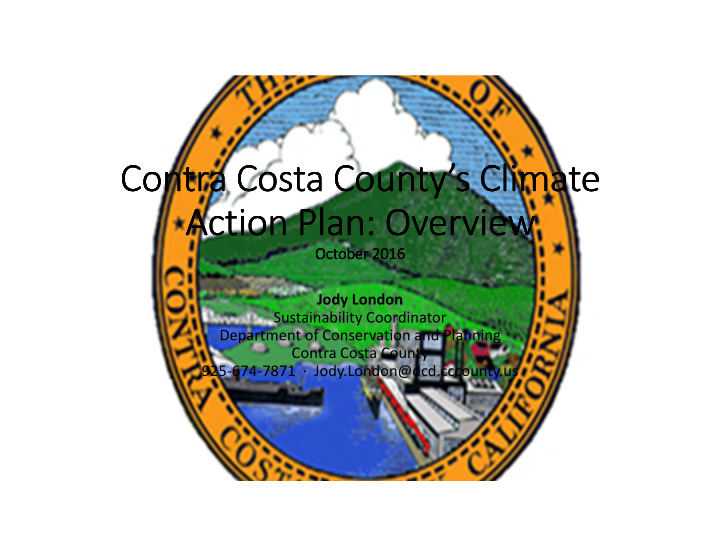



Contra Costa County’s Climate Contra Costa County’s Climate Contra Costa County’s Climate Contra Costa County’s Climate Action Plan: Overview Action Plan: Overview Action Plan: Overview Action Plan: Overview October 2016 October 2016 October 2016 October 2016 Jody London Sustainability Coordinator Department of Conservation and Planning Contra Costa County 925-674-7871 · Jody.London@dcd.cccounty.us
Why Have a Climate Action Plan? Why Have a Climate Action Plan? Why Have a Climate Action Plan? Why Have a Climate Action Plan? • Reduce greenhouse gas emissions/improve air quality • Improve community health and promote health equity • Adapt to climate change impacts • Rising sea levels, including CCC waterfront • More extreme heat events • Drought • Fire • Less fresh water • Meet State environmental requirements • Other benefits, including: • Enhanced quality of life • Lower energy bills • Support local economy 2
Countywide Emissions Countywide Emissions Countywide Emissions Countywide Emissions 2005 GHG Emissions by Sector: Source: Michael Baker International 2015 BART Solid waste Off-road equipment Residential energy <1% 3% 5% 20% On-road transportation 45% Landfill Nonresidential energy Agriculture Water and wastewater 8% 14% 4% 1% 0 200,000 400,000 600,000 800,000 1,000,000 1,200,000 1,400,000 MTCO 2 e – aka “how much carbon?” 3
Emissions from County Operations Emissions from County Operations Emissions from County Operations Emissions from County Operations (2008 Report) (2008 Report) (2008 Report) (2008 Report) 4
Contra Costa County’s 2015 Climate Action Plan: Contra Costa County’s 2015 Climate Action Plan: Contra Costa County’s 2015 Climate Action Plan: Contra Costa County’s 2015 Climate Action Plan: What are the Emissions Reduction Goals? What are the Emissions Reduction Goals? What are the Emissions Reduction Goals? What are the Emissions Reduction Goals? Overall Goals: • Reduce community-wide emissions in unincorporated areas 15% below 2005 levels by 2020 • Trajectory to reduce emissions in unincorporated areas to 50% below 1990 levels by 2035 Note: SB 32 goal is 80% below 1990 levels by 2050 5
Where Will the Reductions Come From? Where Will the Reductions Come From? Where Will the Reductions Come From? Where Will the Reductions Come From? • Energy Efficiency • Waste • Renewable Energy • Water • Land Use and Mobility • Government Operations 6
Energy Efficiency Energy Efficiency Energy Efficiency Energy Efficiency • Residential Buildings: • Non-residential Buildings: • Energy Conservation Awareness: work in progress • Urban Forestry and Paving and Roofing Resources: high-albedo, vegetation or solar, low-impact, pervious surfaces, etc. • Energy Efficiency Capacity Building: grants, workforce • Energy Efficient New Buildings: getting to zero net energy 7
Renewable Energy Renewable Energy Renewable Energy Renewable Energy • Install more renewable energy on homes and businesses • County is looking to assess renewable energy resource potential in Contra Costa County next year • Study will also identify needed modifications to zoning code and ordinances to facilitate renewable deployment • Cite more renewable energy on public lands • Northern Waterfront Economic Development Initiative may yield opportunities for renewable energy, both installation and related businesses 8
Renewable Energy Renewable Energy Renewable Energy Renewable Energy • Financing – Property Assessed Clean Energy now available in unincorporated County 9
Land Use and Transportation Land Use and Transportation Land Use and Transportation Land Use and Transportation • Majority of emissions come from transportation • Increasing County focus on infill, transit-oriented development, complete streets, and related policies • Contra Costa Centre (Pleasant Hill BART) as a model • County fleet is winning awards and recognition • How to reach private fleets? • County collaborates with transit agencies • Northern Waterfront Economic Development Initiative as opportunity to bring jobs closer to housing 10
Land Use and Transportation Land Use and Transportation Land Use and Transportation Land Use and Transportation • Climate Action Plan calls for continued support for local farmers markets, community gardens, school gardens, and other urban agricultural practices • 2017 work will include amending General Plan to encourage community gardens in new residential developments • Siting of new schools is important 11
Waste Waste Waste Waste • State mandates to reduce landfill disposal are pivotal for achieving waste reduction and recycling goals • Interest in generating energy from methane created at landfills, waste water and sewage treatment facilities 12
Community Choice Energy Community Choice Energy Community Choice Energy Community Choice Energy • Feasibility study for community choice energy expected in November • Options: • Form CCE in Contra Costa County • Join MCE (Marin Clean Energy; five cities in CCC already belong) • Join recently approved CCE in Alameda County • Stick with PG&E • Community input process in December and January • CCE could create market opportunities for renewable energy generated in Contra Costa County 13
Water Water Water Water • Water conservation in homes and businesses falls to EBMUD and Contra Costa Water • County may update conservation requirements for new developments • County should begin to promote rainwater collection for irrigation, and allow use of recycled water for irrigation 14
Government Operations Government Operations Government Operations Government Operations Lead by Example! • All traffic signals in unincorporated County are using LED, and street light upgrades are nearly complete • Ongoing energy efficiency audits and retrofits • 5 MW solar • Water efficient landscaping • Opportunities to improve recycling, composting 15
Government Operations Government Operations Government Operations Government Operations • County fleet just received Clean Champion Award from East Bay Clean Cities • Opportunities with: • Upcoming update of Capital Improvements Plan • Potential new County Administrative office • Potential new Emergency Operations Center 16
Discussion Discussion Discussion Discussion • What do you think is the best way to align City and County initiatives on sustainability and climate action planning? • Role of budget and accounting principles – should we be pushing for a move to life-cycle costing, in order to ensure funds for ongoing operation and maintenance of public sector investments? • Who else should be engaged in the County’s Climate Action Plan implementation? • Individuals • Organizations 17
Recommend
More recommend